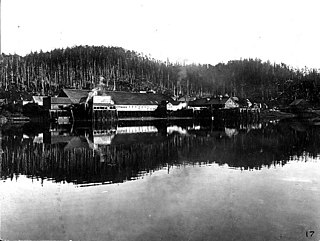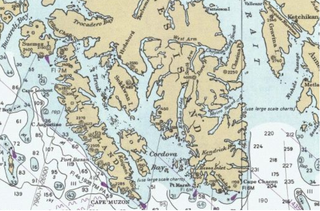Related Research Articles

Orca Inlet is an arm of Prince William Sound in southern Alaska. The town of Cordova was founded on its coast in 1906. All marine traffic reaches the town through Orca Inlet.
Zubof Rock is a small island near Sitka, Alaska, United States, off the northeast coast of Baranof Island. Located in an area of Kelp Bay known as The Basin, it was entered into the United States Geological Survey's Geographic Names Information System on March 31, 1981. Its name dates back to 1895 as Zuboff, which was a Russian surname, as reported by Lieutenant Commander J. F. Moser of the United States Navy.
Cordova Bay is a bay in the Alexander Archipelago of southeast Alaska. It opens onto Dixon Entrance to the south, between Cape Muzon on Dall Island and Point Marsh. The name Puerto Cordova y Cordova was given by the Spanish explorer Lieutenant Don Jacinto Caamaño in 1792, in honor of Admiral Luis de Córdova y Córdova. The name was published by George Vancouver in 1798.

Ernest Sound is a strait in Southeast Alaska, U.S.A. It extends 48 kilometres (30 mi) southwest, from the mouth of Bradfield Canal to Clarence Strait, separating Wrangell and Etolin Islands from the mainland. It was first traversed and charted in 1793 by James Johnstone, one of George Vancouver's officers during his 1791-95 expedition. Vancouver later named it "Prince Ernest's Sound", after Prince Ernest, Duke of Cumberland.

Windham Bay is located 45 miles (72 km) southeast of Juneau, in the U.S. state of Alaska. Windham Bay is listed as site 6 within Southeast Alaska's Zone 3 of the Alaska Dept. of Environmental Conservation's Geographic Response Strategy oil spill response plan. Part of the bay is a protected wilderness area; the Chuck River Wilderness, established in 1990 by the United States Congress, covers an area of 74,506 acres (30,152 ha). The Chuck River flows into Windham Bay, which has a protected anchorage north of Port Houghton, where the historic Chuck Mining Camp once operated.

Port Snettisham is a narrow fjord 30 miles (48 km) southeast of Juneau in the U.S. state of Alaska. It is a semi protected deep water port that was developed to transport many mineral deposits found in the Snettisham Peninsula. Lieutenant Joseph Whidbey of the Royal Navy discovered the fjord on August 12, 1794; George Vancouver named it after the town of Snettisham in England.

Pennock Island is located in the U.S. state of Alaska near the city of Ketchikan. The island is situated within the Ketchikan Gateway Borough and is part of the Alexander Archipelago. Most of the island is public land managed by the Tongass National Forest.
George Inlet is a bay in the U.S. state of Alaska. It is situated within the Alexander Archipelago at the southern shore of Revillagigedo Island. It was named by the U.S. National Geodetic Survey in 1880 after pilot W. E. George, who created the first sketch of Revillagigedo Channel and Tongass Narrows.
Brownson Island is located on the west side of Ernest Sound in the U.S. state of Alaska. Situated within the Alexander Archipelago, the island is 7 miles (11 km) above Onslow Point. It is 7 miles (11 km) long, 1–2 miles (1.6–3.2 km) wide and about 1,000 feet (300 m) in elevation. It is separated from Etolin Island by the narrow Canoe Passage, which is navigable only for boats. A number of small islands are southward of Brownson Island. Several rocks are viewable at low water south of the southern end of Brownson Island.
Union Bay is located in the Alexander Archipelago within the U.S. state of Alaska. It is situated on the northeast side of Lemesurier Point, the south point at the entrance to Ernest Sound. It is 3.5 miles (5.6 km) wide at the entrance, 1.25 miles (2.01 km) at its head, and is about 3 miles (4.8 km) long. At its head is a large lagoon, mostly bare at low water, into which empties a large stream. The waters of the bay are deep, but there is anchorage with good protection from southward, on the east side of the head of the bay, in about 18 fathoms. There is a rock with a depth of 18 feet (5.5 m) in the middle of the bay's entrance and 2.5 miles (4.0 km) northward of Lemly Rock.
Vixen Inlet is located within the U.S. state of Alaska. It is situated 6.5 miles (10.5 km) north-northeast of Lemesurier Point, the south point at the entrance to Ernest Sound. The inlet has a small islet—Sunshine Island—in the middle of its entrance, and a stream at its head. A reef is southward from the south side of Vixen Point. A reef, unmarked by kelp, lies in the middle of the entrance, about 1 mile (1.6 km) west-southwestward of Sunshine Island. There is deep water between it and the shore southward. A rock on each side near the entrance, and a rock inside of Sunshine Island, are recorded.

Hunter Bay is a waterway by Prince Edward Island, part of the Alexander Archipelago, in the U.S. state of Alaska. It is situated 2.5 miles (4.0 km) eastward of Turn Point. The entrance of the bay is about 0.75 miles (1.21 km) wide and is obstructed on its northern side by a number of islets, but the channel close around Turn Point is comparatively clear. About 1 mile (1.6 km) above the entrance, the bay contracts to a width of 825 feet (251 m), with a small grassy islet lying in the middle. The best channel is on the northern side of the islet. At approximately 0.5 miles (0.80 km) eastward of the islet is an arm making northward about 2 miles (3.2 km). The depths are shallow and the tidal currents are strong in the narrowest part. There is good anchorage in Hunter Bay. Near the south shore of the bay is an islet surrounded by a flat of considerable extent. Klinkwan is a native village on the north shore of Hunter Bay at its entrance; it has a white church with two spires. Back of the village is a prominent conical mountain, 2,400 feet (730 m) high. Klakas Inlet joins Cordova Bay westward of the entrance to Hunter Bay.

Isanotski Strait is a strait connecting the northern Gulf of Alaska with the Bering Sea, in the U.S. state of Alaska. Isanax̂ is the Aleut name for present day Isanotski Strait, and means gap, hole, rent, or tear in the Aleut language which was rendered as Isanotski in transliterated Russian. The strait appears as Исанакъ in 1802 and Исаноцкый in 1844 on Russian maps.

Ikatan Bay is a waterway in the U.S. state of Alaska. The bay and Isanotski Strait separate Unimak Island from the Alaska Peninsula. They have been used by light-draft craft, intended for service on the Yukon River, in making the passage from Puget Sound ports to St. Michael.

Ikatan Peninsula is the southeastern extremity of Unimak Island in the U.S. state of Alaska.

Unalaska Bay is a waterway of Unalaska Island in the U.S. state of Alaska. It is situated below the eastern slopes of Makushin Volcano. Composed of seven individual bays, Unalaska Bay opens onto the Bering Sea.

Kaigani Strait is a waterway in the U.S. state of Alaska, the southern part of the strait between Long Island and Dall Island. The Alaska Native name, as reported by Etolin is 1833, is Kalgan.
American Bay is a waterway in the U.S. state of Alaska. It is located on the east side of Dall Island, facing Long Island across Kaigani Strait.

Stikine Sound is a body of water in the U.S. state of Alaska, 12 miles (19 km) north of Wrangell. It was named by Mikhail Tebenkov. It forms where the Stikine River finally reaches salt walter. The delta of the river is the silted-up inland extension of this channel. It is 4 miles (6.4 km) wide and about 20 miles (32 km) in length, with a large number of islands near its eastern end, and lying directly off the flats of the Stikine River.
Cholmondeley Sound is a deep bay or inlet on the southeast side of Prince of Wales Island, in the Alexander Archipelago of southeast Alaska, in Tongass National Forest and connecting to Clarence Strait. The sound's entrance lies between Chasina Point and Skin Island. It is about 20 miles (32 km) west of Ketchikan, Alaska. Cholmondeley Sound has several bays and inlets within it, including Kitkun Bay, Dora Bay, Brennan Bay, and Sunny Cove. At its western end Cholmondeley Sound splits into two fjord-like inlets: West Arm Chomondeley Sound, about 7.5 miles (12.1 km) long, and South Arm Cholmondeley Sound, about 8 miles (13 km) long. The full length from the entrance of the sound to the head of West Arm is about 16 miles (26 km).
References
-
 This article incorporates text from a publication now in the public domain : G. Davidson's "Pacific Coast. Coast Pilot of Alaska: From southern boundary to Cook's Inlet" (1869)
This article incorporates text from a publication now in the public domain : G. Davidson's "Pacific Coast. Coast Pilot of Alaska: From southern boundary to Cook's Inlet" (1869) -
 This article incorporates text from a publication now in the public domain : United States Coast Pilot's "United States Coast Pilot: Alaska. Dixon Entrance to Yakutat Bay. Pt. 1" (1917)
This article incorporates text from a publication now in the public domain : United States Coast Pilot's "United States Coast Pilot: Alaska. Dixon Entrance to Yakutat Bay. Pt. 1" (1917) -
 This article incorporates text from a publication now in the public domain : U.S. Geological Survey's "Mineral Resources of Alaska: Bulletin" (1914)
This article incorporates text from a publication now in the public domain : U.S. Geological Survey's "Mineral Resources of Alaska: Bulletin" (1914)
- ↑ Chamberlain, Frederick M. (1907). Some Observations on Salmon and Trout in Alaska (Public domain ed.). U.S. Government Printing Office. pp. 111–.
- ↑ "Kegan Cove Cabin Site Lookout/cabin". U.S. Forest Service. Retrieved 13 August 2014.
- ↑ Davidson, George (1869). Pacific Coast. Coast Pilot of Alaska: From southern boundary to Cook's Inlet (Public domain ed.). U.S. Government Printing Office. pp. 78–.
- ↑ United States Coast Pilot (1917). United States Coast Pilot: Alaska. Dixon Entrance to Yakutat Bay. Pt. 1 (Public domain ed.). U.S. Government Printing Office. pp. 68–.
- ↑ U.S. Geological Survey (1914). Mineral Resources of Alaska: Bulletin (Public domain ed.). pp. 82–.